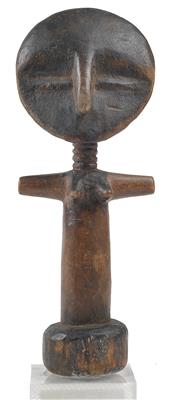Ashanti, Ghana: An ‘Akuaba’ fertility doll.

Among the Ashanti people, the largest tribe of the Akan group, women hoping for offspring carry these ‘Akuaba dolls’ in their cloths with themselves. Traditionally, these ‘Akuaba’ have a large, round, flat head that is reminiscent of its origin as a representation of the moon goddess, which is associated with fertility. Once the ‘Akuaba’ has fulfilled its purpose, the mother of the desired child places it on her domestic altar, where it is worshipped in a shrine and/or passed on to the next generation. The present, relatively small ‘Akuaba doll’ is made of wood and was originally dyed black. A small, typical tribal scarification mark on the left cheek of the figure. The typical, abstract female body displays a neck with notched rings. On the back of the head runs a horizontal relief band of notched triangles. Overall with good, old patina. Colours scuffed as a result of long use. Minor age damage (nose, back). First half of the 20th century; H: 22 cm. (ME)
Esperto: Prof. Erwin Melchardt
 Prof. Erwin Melchardt
Prof. Erwin Melchardt
+43-1-515 60-465
erwin.melchardt@dorotheum.at
24.03.2014 - 16:00
- Stima:
-
EUR 800,- a EUR 1.000,-
Ashanti, Ghana: An ‘Akuaba’ fertility doll.
Among the Ashanti people, the largest tribe of the Akan group, women hoping for offspring carry these ‘Akuaba dolls’ in their cloths with themselves. Traditionally, these ‘Akuaba’ have a large, round, flat head that is reminiscent of its origin as a representation of the moon goddess, which is associated with fertility. Once the ‘Akuaba’ has fulfilled its purpose, the mother of the desired child places it on her domestic altar, where it is worshipped in a shrine and/or passed on to the next generation. The present, relatively small ‘Akuaba doll’ is made of wood and was originally dyed black. A small, typical tribal scarification mark on the left cheek of the figure. The typical, abstract female body displays a neck with notched rings. On the back of the head runs a horizontal relief band of notched triangles. Overall with good, old patina. Colours scuffed as a result of long use. Minor age damage (nose, back). First half of the 20th century; H: 22 cm. (ME)
Esperto: Prof. Erwin Melchardt
 Prof. Erwin Melchardt
Prof. Erwin Melchardt
+43-1-515 60-465
erwin.melchardt@dorotheum.at
|
Hotline dell'acquirente
lun-ven: 10.00 - 17.00
kundendienst@dorotheum.at +43 1 515 60 200 |
| Asta: | Tribal Art |
| Tipo d'asta: | Asta in sala |
| Data: | 24.03.2014 - 16:00 |
| Luogo dell'asta: | Wien | Palais Dorotheum |
| Esposizione: | 18.03. - 24.03.2014 |
Lotti da altre aste
- Brillantsolitär Ring ca. 0,52 ct
- Otto Prutscher (Wien, 1880-1949), "Stengelglas" ("Weinglas"), Meyr's Neffe, Adolf, für E. Bakalowits Söhne, Wien, 1916
- Briefstück - Österr. Nr. 3H type IIIa dunkelrot auf Briefstück mit einem waagrecht sitzenden,
- Schweizer Schnupftabakdose,
- Ohrsteckgehänge mit behandelten Topasen zus. ca. 14,25 ct
